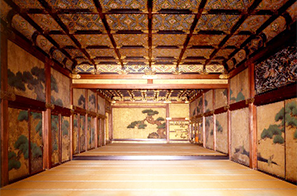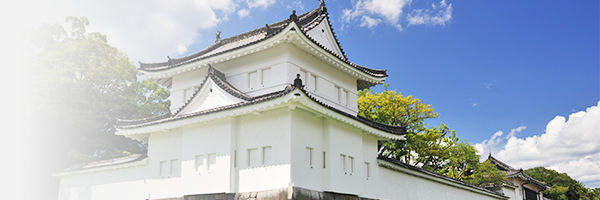Imperial Visit by Emperor Go-Mizuno-o
In order to further cement the position of the Tokugawa shogunate, Princess Masako, one of the daughters of the second Shogun, Hidetada, became the consort of the reigning Emperor, Go-Mizuno-o, in 1620. The castle was repaired in 1619 in preparation for this event, and the Princess set off from the Nijo-jo Castle on June 18, 1620, in procession with an enormous retinue for the Imperial Palace. In September 1626, the Emperor Go-Mizuno-o made an Imperial Visit to the Nijo-jo Castle, at the invitation of the retired second Shogun Hidetada and his son, the third Shogun Iemitsu, who both came to Kyoto for the five-day imperial visit. For this event, the castle was repaired and expanded to its current size, starting in 1624. The keep tower, the Gyoko-goten Palace for the Emperor, and the Honmaru-goten Palace were constructed for the festivities. Stunning wall paintings were created by painters of the Kano School, the official painters to the Shogunate. During the Imperial visit, there were performances of Noh theater, waka (classical Japanese poetry) composition gatherings, traditional music performances, horseback riding, and Court kemari (a Court ball game). After the imperial visit, the Gyoko-goten Palace and several other buildings were dismantled. The keep tower and the Honmaru-goten Palace were later destroyed by fire. The Ninomaru-goten Palace serves as an important reminder of this, the high-point of the Castle’s history. 1634 was the last time that a Shogun stayed at Nijo-jo Castle until 1863, and, during this period, the castle went into a long period of decline.
Restoration of Imperial Rule
- In 1867, the end of the political rule of the Tokugawa Shogunate and the restoration of power to the Emperor was proclaimed at Nijo-jo Castle. At the end of 18th century, the arrival of overseas delegations demanding the opening of Japanese ports forced the Shogun to sign treaties bringing an end to approximately 200 years of Japanese isolation from the outside world. The Shogun decided to seek approval for these treaties from the Imperial Court, which caused considerable confusion since it questioned the authority of the Shogun. Samurai mainly from southern Japan plotted to bring an end to the Tokugawa Shogunate and to return political power to the Emperor by force. In response, the 15th Shogun, Tokugawa Yoshinobu, summoned senior vassals from 40 domains who were resident in Kyoto to the Ohiroma of Ninomaru-goten Palace on October 13, 1867, and solicited their opinions. On the following day, the Shogun announced his intention to return his political authority to the Imperial Court, which was accepted by the Emperor on October 15, 1867. Although there was some resistance, including outbreaks of warfare, Edo Castle was handed over to the new Imperial Government without bloodshed in the spring of 1868, marking the end of the Tokugawa period and the beginning of the modernization of Japan. Political power was thereby restored to the Emperor, and the Meiji period began. Thus, this is known as the Meiji Restoration.

Enthronement Banquet for Emperor Taisho
The enthronement of the Meiji Emperor’s heir, the Taisho Emperor took place in 1915 in the Ceremonial Hall of the Kyoto Imperial Palace. After the ceremonies at the Imperial Palace, a banquet attended by Imperial officials, foreign dignitaries invited to the enthronement, and the Prime Minister was held at the Nijo-jo Castle, which had become an Imperial Villa after the Meiji Restoration. A number of new buildings were added to the Castle for the festivities, all of which were later dismantled with the exception of the Minami-mon(South Gate).



